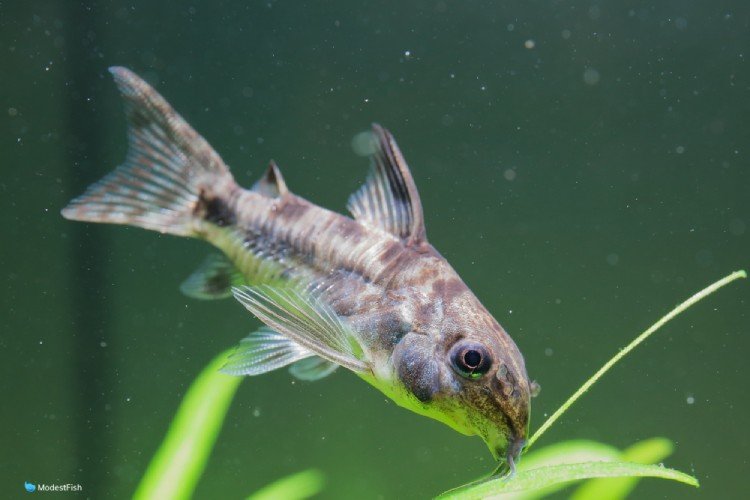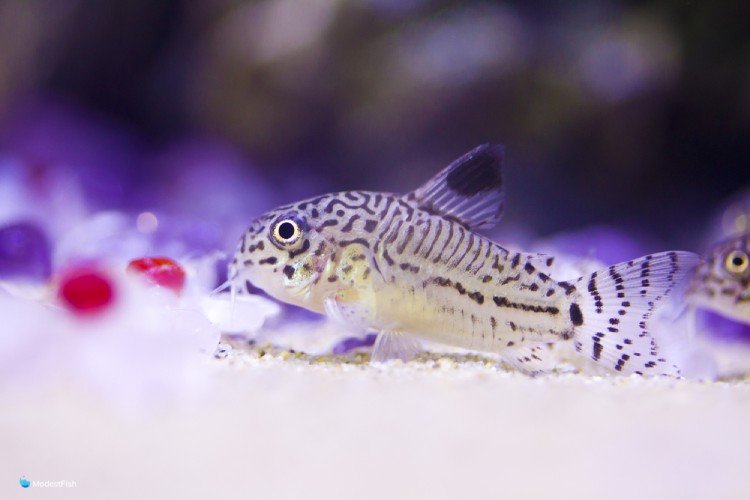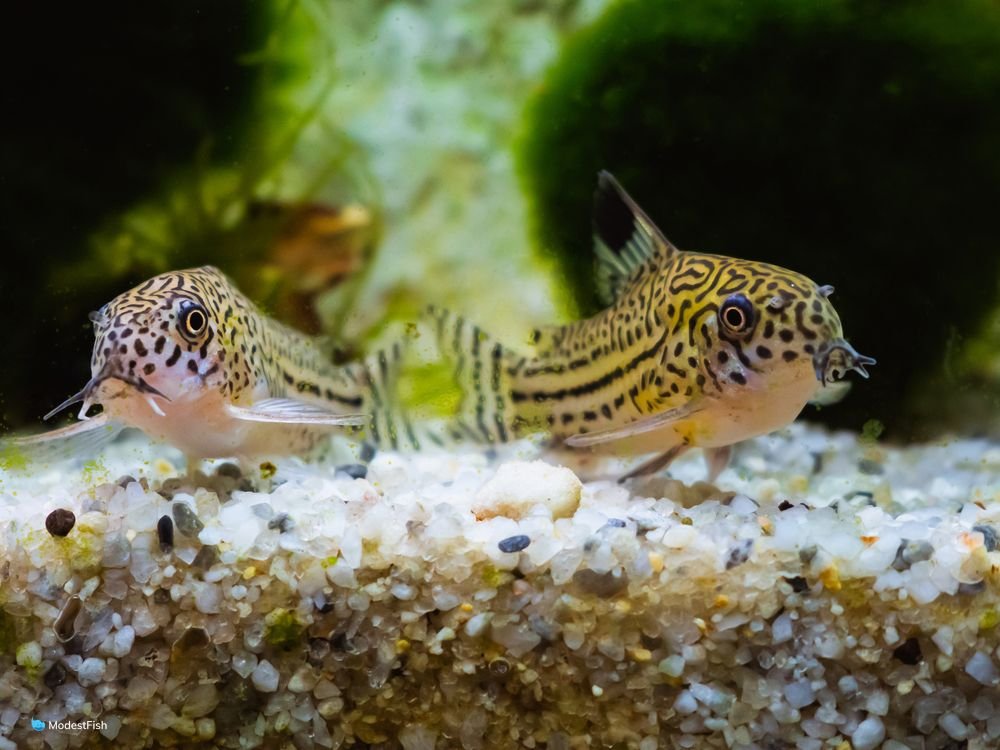With 160 species of Corys, they’re almost essential to have in every tank and require a manageable level of care.
And as peaceful bottom-dwellers, there are tons of great tank mates to pick from.
In this guide, I’ll provide you with all the information you need to provide optimal care for cory catfish so they live a long and happy life.
Origin, Appearance, & Care Overview: Cory Catfish
Cory Catfish originate in South America, and their natural habitats are usually small streams, ponds, rivers, marshes, and shallow waters.
Known as armored fish, Cory catfish are unique because of their bone-like plates that run through the length of their frames. They have a small, short face and pectoral fins that protrude and rest on the surface.

Their colors match the browns of riverbeds, which help them camouflage. You can also find unique colored Cory Catfish, such as the Emerald Green CoryCat. All Cory fish have a cute disposition and wide eyes that give them a delicate appearance.
Care Stats Overview
These statistics give you an overview of some essentials to help keep your Cory Catfish healthy, cared for, and happy.
- Common Names: Cory Cats, Cory Fish, and Corydoras Catfish
- Tank Size: 20 to 30-gallon tank
- Temperature: 72°F – 78°F
- pH: 7.0-7.8
- kH: 3-10 DH
- Living Zone: Bottom dwellers
- Temperament: Peaceful and easy-going!
- Diet: Omnivores – such meaty foods like shrimp combined with algae and plants would suffice. Food will need to sink to the bottom of the tank for your Cory Catfish to catch it.
Scientific Classification
If you like to know more scientific information about these South American fish, here are a few:
- Kingdom: Animalia
- Phylum: Chordata
- Class: Actinopterygii
- Order: Siluriformes
- Family: Callichthyidae
- Genus: Corydoras
- Species: Varies
Life Span For Cory Catfish
Their hardy nature and armored exterior mean their lifespan tends to be longer than other fish. Under the right conditions, the lifespan of Cory Catfish can be 5 years or more, provided that they aren’t put under stress and given good nutrition.
Sexual Dimorphism: Size & Coloration
Usually, female Cory Catfish are wider than males and also tend to be deeper and plumper; this is essential for breeding. Also, females also tend to grow larger than males, with females growing up to 3 inches long while males to 2.5 inches.
Males tend to be more streamlined and smaller, but both don’t have color differences. Additionally, females have rounder fan-shaped fins, while males have more pointed dorsal fins.
Cory Catfish Care & Tank Set-Up

The below pointers are required to be followed as they will help get your tank in optimum condition, which will help your Cory feel comfortable.
Tank Size & How Many Can Be Kept Together
Though Cory’s are little fish, they’re sociable and like to be kept in schools. A 20 to 30-gallon tank will ensure you can keep about 8 Corydoras along with some other small fish. It provides plenty of space for all the little fish to swim around each other.
The Nitrogen Cycle
The Nitrogen cycle is a natural biological system where nitrogen converts into different forms. The nitrogen cycle part is essential as it keeps the ecosystem safe and healthy for fish to thrive.
Fish produce ammonia as waste, and bacteria convert this waste into nitrites and eventually into nitrates. This leaves nitrate as a waste product in your aquarium, and a high concentration of nitrate can cause fish to become weak, especially in the case of Corydoras.
To keep on top of nitrate levels, make a habit of keeping the tank in good condition. Change the water regularly and wipe away algae build-up. This will prevent your fish from catching diseases through waterborne parasites. Moreover, adding live plants to your tank will help keep nitrates level down, as plants consume nitrates to help them grow.
Water Parameters
Cory Catfish like consistency, and therefore the most important point to remember is to maintain stable conditions rather than getting every exact measure. The factors below are essential to consider for your aquarium.
- Temperature: Most Cory Catfish thrive in temperatures between 72 to 82°F. You can find Catfish that enjoy the cooler end of this spectrum, but this temperature spectrum covers what they find comfortable for all Catfish. Make sure that the temperature remains consistent, don’t dramatically change the temperature they’re in as it can lead to stress.
- pH: In your tank, aim for a pH between 7.0-7.8. This would work for more Cory species, and due to their hardy disposition, they can withstand slightly more acidic and alkaline conditions. Remember, like temperature, keep the pH levels consistent; avoid changing it too much.
- kH: For the water hardness, aim for 3-10 DH.
- Hardness: Water hardness can easily be adjusted by adding some baking soda to increase hardness. If your water needs softening, use a shower head filter or an electronic water softener.
Tank Set-Up
As bottom dwellers, it’s important to keep about 2 inches of a soft, sandy substrate. Cory Catfish have delicate barbels that help them reach out to food; therefore, sand or rounded gravel substrate is ideal. Anything sharp will damage Cory’s whiskers and lead to cuts and infections.
Moreover, Cory Catfish love hideouts as places for rest and cover; therefore, they like having live plants around, which also help keep nitrate levels stable in your tank. You can also add decorations for your Cory Catfish to swim around in and explore, and regular aquarium lighting would be fine for these fish.
As native to South American rivers, Corys like to have a bit of current in the water flow of the aquarium to keep them thriving, energetic, and playful. Keep an eye out though, having too strong a current can stress them out, so if you see them constantly resorting to the plants for grounding, reduce the flow.
Diet & Feeding
As omnivore creatures, they enjoy meaty foods such as shrimps and worms of all types. But Corys aren’t too fussy. They can do just fine with fish flakes and pellets. Whatever you choose, make sure it sinks as Cory Catfish enjoy rummaging and digging around the substrate for food.
This makes them good tank cleaners, too, as they’ll eat all the sunken, uneaten food. However, avoid relying on feeding them leftovers, as they do need good nutrition.
Behavior and Tank Mate Compatibility

Most community tank fish will get on well with Cory Catfish. Because Corys are peaceful, friendly, and non-aggressive, it’s essential to introduce tank mates with the same disposition.
Examples of good tank mates:
- Otocinclus Catfish
- Tetras
- Swordtails
- Other Cory Catfish species
- Shrimps species, such as Bamboo Shrimp, Vampire Shrimp, Amano Shrimp, Red Cherry Shrimp, and Ghost shrimp
Bad tank mates would be fish that are known to be aggressive or significantly more prominent than Corys. Also, fish that have a reputation for injuring or eating smaller fish should be avoided.
Examples of bad tank mates would be:
- Cichlids
- Aquarium Crayfish
- Oscars
- Texas Cichlids
- Jack Dempseys
Breeding Cory Catfish
Breeding Cory Catfish requires only a few conditions to get the ball rolling. Place the male and female in a separate tank and begin by feeding them lots of nutritious, protein-rich food, such as shrimp and bloodworms and induce spawning by slightly cooling the water and keeping it consistent.
Ensure your sandy substrate is in place to help them feel comfortable and check that you have enough plants, such as java fern or aquarium grass that can provide the essential cover they require.
After the eggs are laid, remove the two parents and place them back into the community tank as they may eat the eggs. Once hatched, the new fry won’t need feeding until 48 hours. When you notice them wriggling and swimming around, feed them twice a day with powder food, then after a few days, add live or dead protein to their meals.
Will You Choose The Cory Catfish?
These small but hardy fish are a breeze to keep, not to mention the many advantages they offer when added to a community aquarium. As bottom dwellers, they help keep your tank clean and are easy to introduce to a community of fish due to their peaceful disposition.
They’re also a pleasure to keep and entertaining to watch, as they can be very active and love to interact with shrimp, snails, and other fish.
Unlike many fish, they won’t always resort to taking cover and enjoy a bite to eat with fellow tank mates. You’ll see how easily they get along with others without spooking other tank mates away.
They aren’t fussy with their food or lighting! Factors to be mindful of would be keeping the tank clean, watching for nitrate levels, water flow, and temperature.
With all the factors discussed, it’s all about keeping things consistent to ensure your Corys are happy.
